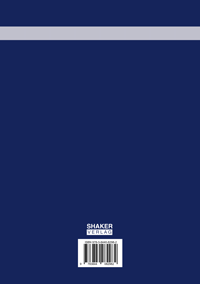
Shop : Details
Shop
Details
45,80 €ISBN 978-3-8440-8298-2Paperback136 Seiten60 Abbildungen200 g21 x 14,8 cmEnglischDissertation
November 2021
Kamil Braschke
Modeling contact behaviour of arbitrarily shaped particles
The process of filtration (i.e., the separation of a disperse phase from a fluid) is widely applied in the industry. The variety of applications implies that filtration technologies have to cater to an accordingly huge range of requirements. To meet the constantly increasing demands, researchers often conduct experiments on a macroscopic scale, which means that either the filter as a whole is investigated or smaller segments of it are. In both cases, phenomena that take place on a much smaller scale, such as the interactions of single particles with other particles or with the filter medium itself, cannot be fully comprehended. Although it is possible to experimentally analyse more isolated filtration processes, as it is the case in single fibre deposition measurements, it is often impossible to analyse a sample without destroying or damaging it – which, in turn, hampers a more precise description of a transient loading procedure. Numerical simulations represent a valuable addition to those measurements because they deliver reproducibility and control of relevant parameters – which, as of now, is not achievable in experiments. Particularly in the context of microscale research of single fibre deposition, numerical simulations are capable of yielding transient data of particle interactions that are otherwise difficult to obtain. Common simulations in that field tend to simplify the process of deposition by assuming spherical particles and employing models for rebound or adhesion which also rely on a spherical shape. Therefore, the work at hand introduces methods for the calculation of adhesive van der Waals forces and impact mechanics which are independent of particle geometry, with forces resolved at the particle’s surfaces. The presented methods are developed for the simulation software package OpenFOAM® and are part of the in-house developed library ABSFoam responsible for representing the solid phase through an immersed boundary method. Algorithms have been implemented with care; thus, an acceptable computation time can be achieved for simulations with numerous particles. The developed models were validated theoretically and, where possible, compared to the literature. The work concludes with a presentation of single fibre deposition simulations under various conditions.
Schlagwörter: CFD; filtration; IBM; particles; adhesion; collision; agglomeration
Berichte des Fachgebiets für Strömungsmechanik
Herausgegeben von Univ.-Prof. D.-Ing. habil. Uwe Janoske, Wuppertal
Verfügbare Online-Dokumente zu diesem Titel
DOI 10.2370/9783844082982
Sie benötigen den Adobe Reader, um diese Dateien ansehen zu können. Hier erhalten Sie eine kleine Hilfe und Informationen, zum Download der PDF-Dateien.
Bitte beachten Sie, dass die Online-Dokumente nicht ausdruckbar und nicht editierbar sind.
Bitte beachten Sie auch weitere Informationen unter: Hilfe und Informationen.
Bitte beachten Sie auch weitere Informationen unter: Hilfe und Informationen.
| Dokument |  | Abstract / Kurzzusammenfassung | ||
| Dateiart |  | |||
| Kosten |  | frei | ||
| Aktion |  | Anzeigen der Datei - 308 kB | ||
| Aktion |  | Download der Datei - 308 kB | ||
| Dokument |  | Gesamtdokument | ||
| Dateiart |  | |||
| Kosten |  | 34,35 € | ||
| Aktion |  | Zahlungspflichtig kaufen und anzeigen der Datei - 1,3 MB | ||
| Aktion |  | Zahlungspflichtig kaufen und download der Datei - 1,3 MB | ||
| Dokument |  | Inhaltsverzeichnis | ||
| Dateiart |  | |||
| Kosten |  | frei | ||
| Aktion |  | Anzeigen der Datei - 386 kB | ||
| Aktion |  | Download der Datei - 386 kB | ||
Benutzereinstellungen für registrierte Online-Kunden (Online-Dokumente)
Sie können hier Ihre Adressdaten ändern sowie bereits georderte Dokumente erneut aufrufen.
Benutzer
Nicht angemeldet
Export bibliographischer Daten
Shaker Verlag GmbHAm Langen Graben 15a52353 Düren
Mo. - Do. 8:00 Uhr bis 16:00 UhrFr. 8:00 Uhr bis 15:00 Uhr
Kontaktieren Sie uns. Wir helfen Ihnen gerne weiter.



